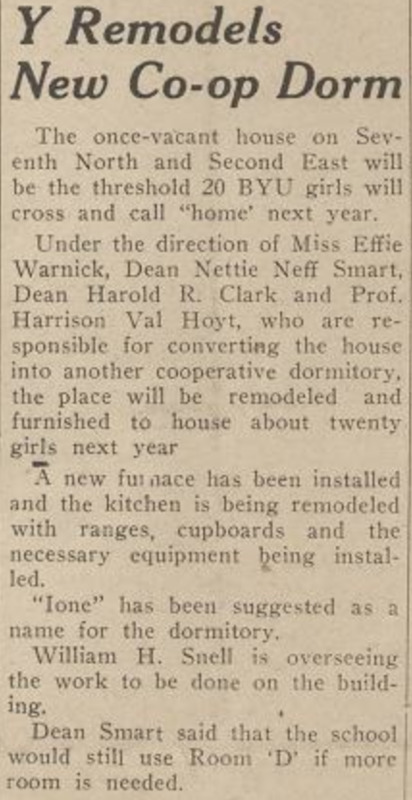Iona House

Named after the philanthropic Knights’ youngest daughter, Iona House had a colorful half-century life as a dormitory, missionary training home, therapy clinic, and Spanish laboratory.
Born December 18, 1891 in Provo, Addie Iona Knight was the youngest daughter of Latter-day Saint philanthropists Amanda McEwan Knight and Jesse Knight. Her older brother, J. William, recalled that Iona had “a keen intellect, a generous heart, and an unusually intelligent sense of humor.” Always eager to learn, Iona enjoyed discovering the world beyond Utah, and in 1907 she traveled throughout Europe (with a BYU professor chaperone).
Iona was well-educated; she studied first at Brigham Young University, then West Lake School for Girls in Los Angeles, and finally Stanford University in Palo Alto. While at Stanford, Iona befriended Professor David Starr Jordan—a renowned ichthyologist whose controversial legacy includes both democratizing education and propounding racist eugenics—and his wife Jessie Knight.
Iona moved back and forth between Provo and California, and she had a brief stint teaching in BYU’s English Department. She remained close to David and Jessie throughout her life and even moved back to Palo Alto to live with them during David’s final, ailing years. Iona remained in California, and she also died there after a long illness on May 7, 1937. She was buried with the rest of the Knight family in Provo.
The building’s story has its roots in 1942, when World War II defense workers flooded Provo, creating a housing shortage for students. To alleviate this, 1940s BYU bought houses and turned them into “co-op” student residences. Warnick House was the first, bought in 1942, and BYU considered it such a success they purchased and renovated a second in 1943, which they named Iona House, after the late English teacher.
Like Warnick, Iona was a “co-op.” Student residents shared bedrooms, restrooms, a kitchen, and communal spaces, and they bore responsibility for working together to manage the home. Cooperative living had its pluses; residents always had a group to hold activities with, whether potlucks or sled parties, and they knew how to work together. For example, in a 1945 Women’s Athletic Association softball tournament with several other dormitories plus PEMM (the Physical Education Majors club), Iona’s residents lost only one game and overall tied with PEMM. Three years later, the 1948 residents won the Homecoming parade’s best humor award for their float, which “portrayed college life in the dormitories and completed the task so well.”
In 1959, the need for men’s housing increased such that Iona House switched from a women’s residence to a male graduate student residence. For the next three decades, Iona served numerous purposes. In the 1960s or 1970s, Church missionaries learning to speak Navajo lived in Iona, and from sometime in the 1970s until 1976, sister missionaries learning Italian lived there. From 1976 to at least 1979, BYU Marriage and Family Counseling held its clinic in Iona. Finally, in the 1980s, Iona was the “Spanish House” for students in the intensive Spanish language program.
In the early 1990s, BYU decided Iona had run its course. It demolished the building and apparently sold the lot; today, townhouses fill the property.
Images











